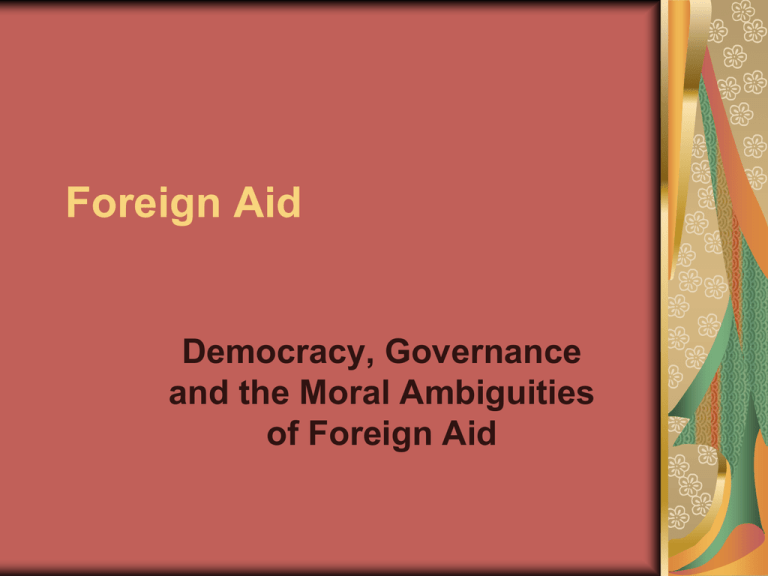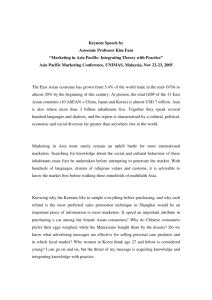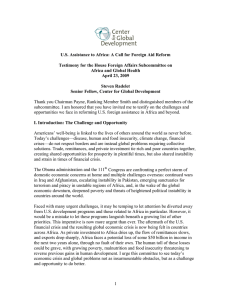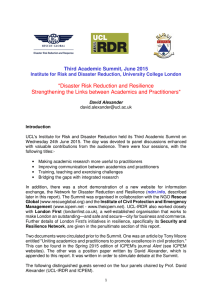Foreign Aid - University of Pittsburgh
advertisement

Foreign Aid Democracy, Governance and the Moral Ambiguities of Foreign Aid The International Donor Regime Private Foundations vs. Government Donors Official Development Assistance (ODA) Bilateral Donors vs. Multilateral Assistance Multilateral Organizations United Nations Development Programmme UN Specialized Agencies: UNICEF ILO FAO UNESCO FAO UN System: Two Types Funds and Programs- Report to Economic and Social Development Council Specialized AgenciesAutonomous Boards Basic Characteristics: UN System Made up of components of all National Systems Representative: Voting Reflects LDC majority Critics: Anarchy Significant Patronage and Corruption The World Bank System International Monetary Fund: Bridging Loan Facility International Bank for Reconstruction and Development- Infrastructure International Development AssociationConsessional International Finance Corporation: Commercial Rates Bank HeadquartersWashington D.C. Characteristics of World Bank System Block Voting Dominated by Organization for Economic Construction and Development (OECD) Debt Forgiveness Issue Structural Adjustment Vehicle Heavily Indebted Poor Countries (HIPC) Programs Regional Banks Asian Development Bank African Development Bank Inter-American Development Bank European Bank for Reconstruction and Development U.S. Agencies U.S. Agency for International Development Millennium Challenge Corporation Office of the U.S. Global AIDS Coordinator State Department of Public Affairs U.S. Agencies: Agriculture, Commerce, Labor Defense Department (20% in 2008) Pentagon Commonwealth Legacy Colonial Development Corporation: 1929 Colombo Plan: 1955-1964 Commonwealth Fund for Technical Cooperation Department for International Development (DFID) U.K. Foreign Aid Commonwealth Donors Canadian International Development Corporation (CIDA)Bridges French and English Speaking Countries Australia- Ausaid (Focus on Asia) New Zealand Aid Countries that are both Donors and Recipients India China South Africa Brazil Portugal European Colonial Legacy Ministry for Cooperation, Development and Francophony GTZ- German Technical Assistance and German Department of Cooperation and Development Dutch, Italian and Belgium Technical Assistance Scandinavia: “Soft Donors” SIDA- Swedish International Development Association DANIDA- Danish International Development Association NORAD- Norwegian Agency for Development Coorporation FINNAID-Finnish foreign aid and cooperation Danish International Development Agency Role of Soviet Block Soviet Union- 1950s. About 8% of World Foreign Aid 1970s and 1980s- Support for Liberation Movements and Clients 1990s to Present- Became Recipients of Foreign Aid The Donor System Soft Vs. Hard Systems Trade vs. Aid Debt Reduction/Debt Forgiveness Governance Reform vs. Interference Information Technology Multilateralism vs. Unilateralism Goals: 2006 Ostensibly, the goals of foreign aid in 2006 remain what they were more than half a century ago. However, Issues and Perceptions have changed and are Changing Changes in Focus The Change- 1 Reduction of Poverty Reduction of Poverty Recognized empirically by academic studies Argued against ideologically by AntiKeynesian Economists Reflected in State Department Changes Poverty Alleviation Downgraded by 2001 Change -2: The Merging of USAID and State The Merging of USAID and State 1. Rice Announcement- Gradual process: Integrating USAID into State Department 2. Merge defense and foreign aid (Security Imperative) 3. Focus on regime change, governance and security issues 4. Decline in focus on economic and social development 2006 Debate: Should USAID Disappear? Three influences Impact of September 11 HIV/AIDS Millenium Challenge Account PEPFAR- HIV/AIDs: Happy Talk The Change- 3 Changing Motives Three Views of Foreign Aid 1. Part of Balance of Power- Carrot and Stick Approach (based on exchange Theory) 2. Commercial Promotion: Focus on International Trade 3. Humanitarian Theory: Moral Imperative (Missionary Factor) Mini-Discussion: Where are we now? Change Four: The Relationship between Academics and Practitioners Increasing Gap between Academics and Practitioners Fewer Academics are practitioners, fewer practitioners write Issue: Should academics also be practitioners? Patterns 1950s- Very close 1960s-70s- Split because of Vietnam 1980s- Close Again- Structural Adjustment University of Pittsburgh. Graduate School of Public and Internationa Affairs. International Management Development Institute 1990s and esp. since 2001 Split again After 2001- Deep Cleavage Change-4 Increasing Gap between Academics and Practitioners Fewer Academics are practitioners, fewer practitioners write Focus: For Profits & Non-Profits Change Five: Dominant Motive (After 2001) Carrot and Stick Approach- Based on Exchange Theory Back to Balance of Power Primary focus: U.S. Security Break TEN Minutes Cartoon In UAE News Paper On "America And Its Carrot And Stick Policy Towards Israel" Change-Six Contemporary Foreign Aid Foreign Aid and Technical Assistance-2006 Back to the future Get the LDC economy back to the 1950s Integration: Dependent development Is it dependent and is it development? Foreign Aid and Technical Assistance-2006 Current bias to international trade Governance and Nation Building Merging of international assistance and security Dr. Ed Connerley, USAID, Meeting Civil Society Representatives in Afghanistan Foreign Aid and Technical Assistance- 2006 Issues Impact of culture vs. Universal Values Corruption, clan and ethnicity Clans in Somalia and taxi drivers in Washington Impact of Intellectual systems and ideologies influences and beliefsEconomic and Religious Projects and Standard Operating Procedures Historical Quote With God’s help, we will lift Shanghai up and up, ever up, until it is just like Kansas City.[i] [i] American Missionary quoted byJohn Franklin Campbell, The Foreign Affairs Fudge Factory (New York: Basic Books, 1971), p. 178. Discussion of Books Hancock, Lords of Poverty Perkins, Confessions of an Economic Hit Man – Major Arguments – Normative Positions – Criticism Where are We now? Should we focus on the “Good” How Fair are our authors? Are we missing something in our reading and discussion? What is the reality of Foreign Aid in 2009








